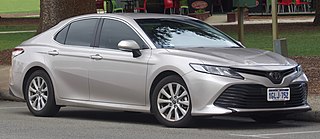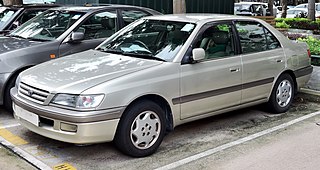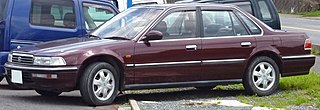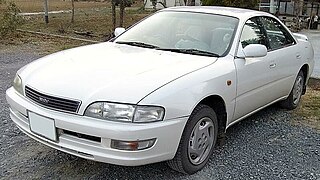
The Toyota Celica is an automobile produced by Toyota from 1970 until 2006. The Celica name derives from the Latin word coelica meaning heavenly or celestial. In Japan, the Celica was exclusive to the Toyota Corolla Store dealer chain. Produced across seven generations, the Celica was powered by various four-cylinder engines, and bodystyles included convertibles, liftbacks, coupés and notchback coupés.

The Toyota Supra is a sports car and grand tourer manufactured by the Toyota Motor Corporation beginning in 1978. The name "supra" is derived from the Latin prefix, meaning "above", "to surpass" or "go beyond".

The Toyota Camry is an automobile sold internationally by the Japanese auto manufacturer Toyota since 1982, spanning multiple generations. Originally compact in size (narrow-body), the Camry has grown since the 1990s to fit the mid-size classification (wide-body)—although the two widths co-existed in that decade. Since the release of the wide-bodied versions, Camry has been extolled by Toyota as the firm's second "world car" after the Corolla. As of 2022, the Camry is positioned above the Corolla and below the Avalon or Crown in several markets.

The Buick Skyhawk is an automobile produced by Buick in two generations for the 1975 through 1989 model years.

The Toyota Corona is an automobile manufactured by the Japanese automaker Toyota across eleven generations between 1957 and 2001. On launch, the Corona was Toyota's second-highest product in their range, just below the Crown. The Corona was marketed in the JDM at Toyota's Toyopet Store dealership channels, and the Corona was one of Toyota's first models exported to other global markets, followed by the smaller Toyota Corolla.

The Honda Ascot is a compact sedan manufactured by Honda and marketed only in Japan from 1989 until 1997. The first generation produced two versions based on the Honda Accord CB series called the Ascot and from 1993 to 1996 a "pillared hardtop" called the Ascot Innova. The Innova shared much of its mechanicals with the European-market Accord manufactured at the Honda UK facility in Swindon, England, and was essentially the badge engineered Rover 600. The second generation was a platform improvement, shared with the Japan-only sedan called the Honda Rafaga. The "Ascot" name was chosen with reference to the Ascot Racecourse and Ascot tie, in order to add the model an alleged air of class and elegance. Honda Ascot was also used on a range of one-cylinder motorcycles in the first half of the 1980s.

The Mazda Persona is a mid-sized, front-wheel drive, four-door hardtop sedan produced by Mazda in Japan from November 1988 to December 1991, and sold both within its main range and under its upscale Eunos brand, as the Eunos 300. It is a rebodied Capella/626 with more luxurious equipment. The Persona was Mazda's answer to the Toyota Carina ED, Nissan Presea, and Mitsubishi Emeraude — Japanese sedans that attempted to capture the pillarless hardtop look and proportion of large American sedans. Transposed onto a smaller Japanese sedan, this proportion often led to a small, low cabin in context of longer front and rear ends. It was replaced by the ɛ̃fini MS-8 in March 1992, after Persona stocks had run out. The car was only offered new in the domestic Japanese market.

The Nissan Laurel is a two- and four-door sedan manufactured and marketed by Nissan from 1968 to 2002. Later generations added all-wheel-drive along with turbocharged engines. Introduced in 1968 as a new model positioned above the Datsun Bluebird 510, the Laurel offered the luxury of the Nissan Gloria A30 in a shorter wheelbase, and has always been the luxury version of the Skyline range for all generations, sharing engines, suspensions and handling dynamics of the popular performance coupe and sedan while having a longer wheelbase.

The Toyota Chaser is a mid-size car produced by Toyota. In the beginning, Chasers were four-door sedans and hardtop sedans; a two-door coupé was available only for the first generation. It was introduced on the 1976 Toyota Corona Mark II platform and was only available at Japanese Toyota Vista Store dealerships, and was later joined with the Toyota Cresta. The Chaser was produced for six generations; production ceased in 2001 when both it and the Cresta were replaced by the short-lived Verossa.

The Toyota Mark II is a compact, later mid-size sedan manufactured and marketed in Japan by Toyota between 1968 and 2004. Prior to 1972, the model was marketed as the Toyota Corona Mark II. In some export markets, Toyota marketed the vehicle as the Toyota Cressida between 1976 and 1992 across four generations. Toyota replaced the rear-wheel-drive Cressida in North America with the front-wheel-drive Avalon. Every Mark II and Cressida was manufactured at the Motomachi plant at Toyota, Aichi, Japan from September 1968 to October 1993, and later at Toyota Motor Kyushu's Miyata plant from December 1992 to October 2000, with some models also assembled in Jakarta, Indonesia and Parañaque, Philippines as the Cressida.

The Gloria is a large luxury car made from 1959 by the Prince Motor Company, and later by Nissan Motors since its merger with the former - hence being originally marketed as Prince Gloria and later as Nissan Gloria. Initially based on the smaller Prince Skyline, the Gloria line was merged with Nissan Cedric starting with 1971 models and both continued until 2004, when they were both replaced by Nissan Fuga.

The Toyota Carina is an automobile which was manufactured by Toyota from December 1970 to December 2001. It was introduced as a sedan counterpart of the Celica, with which it originally shared a platform. Later, it was realigned to the Corona platform, but retained its performance image, with distinctive bodywork and interior — aimed at the youth market and remaining exclusive to Japanese Toyota dealerships Toyota Store. It was replaced in Japan by the Toyota Allion in 2001 and succeeded in Europe by the Toyota Avensis.

The Toyota Premio and its twin the Toyota Allion are sedans sold in Japan from 2001 to 2021 by Toyota. The sedans are designated as a compact car by Japanese dimension regulations and the exterior dimensions do not change with periodic updates. Unlike Toyota's other vehicles, the Premio and Allion are not exported, and are exclusively sold in Japan only. Size and pricing-wise, the E210 Corolla, introduced to the Japanese market in 2018 succeeds the Premio and Allion.

The Toyota Crown is an automobile which has been produced by Toyota in Japan since 1955. It is primarily a line of mid-size luxury cars that is marketed as an upmarket offering in the Toyota lineup.

The Nissan Leopard is a line of sport/luxury cars built by Japanese carmaker Nissan. The Leopard began life in 1980 and was discontinued in 1999. The Leopard were initially based on the Japanese market Nissan Skyline and Nissan Laurel, then later based on the chassis of their Nissan Cedric and Nissan Gloria contemporaries and were rear wheel drive. Final versions were the contributing factors to Nissan's Infiniti M and J products.

The Toyota Sprinter Marino is a four-door B-pillar hardtop sedan version of the Toyota Sprinter sedan produced between 1992 and 1998 for sale in Japan. The Toyota Corolla Ceres is a slightly restyled version of the Sprinter Marino, as was common practice by Japanese automakers in the 1980s and 1990s.

The Corolla E100 was the seventh generation of cars sold by Toyota under the Corolla nameplate. This generation of Corolla was larger, heavier, and visually more aerodynamic than the model it replaced. With its 2,465 mm (97.0 in) wheelbase, the Corolla had moved into the compact size class once occupied by the Corona and Camry. The Corolla again had an equivalent model Sprinter, with the Sprinter Trueno being equivalent to the Corolla Levin and both exclusive to Toyota Vista Store Japanese dealerships.

The Corona EXiV is an automobile manufactured by Toyota Motor Corporation. Released in 1989, it was the luxury hardtop version of the Corona and was introduced to emulate the twin Carina ED. The letters EXiV are derived from the words EXtra impressiVe. It was only sold in Japan and was exclusive to Toyota Japan dealerships called Toyopet Store locations and sold next to the Corona. The Corona EXiV was a clone of the Carina ED and shared the same Toyota "T" platform as Celica. The Carina ED was exclusive to Toyota Store locations, and the Celica was exclusive to Toyota Corolla Store locations. When the EXiV was discontinued, the Toyota Progrès appeared for the market segment served by the EXiV.

The Toyota Cresta is a mid-size car built by Toyota. It was launched in 1980 and shared the chassis with the Mark II/Cressida, sold at Toyopet Store dealerships in Japan. The goal of the Cresta was a higher level of luxury in comparison to the Mark II, while the Chaser was the performance-oriented version of the Mark II, but sold at different dealerships. It is often available with two-tone paint and more interior convenience options, resulting in being more similar to the Cressida sold in export markets. The Cresta was produced for five generations, and production stopped in 2001 when it was merged with the Chaser to form the short-lived Verossa.

The Toyota Carina line of large family cars was introduced in Japan in 1970. It was introduced in Europe in 1971, with A40 and A60 series subsequently appearing soon after their introductions in Japan. In 1984, the A60 series Carina was replaced in the European market by the "Carina II" - essentially a rebranding of the T150 series Toyota Corona launched the previous year in Japan, with some minor alterations to suit the European markets. This trend of Coronas rebadged as Carinas produced for the European market continued for two more generations, with the second Carina II in 1988 and the Carina E in 1992.



























